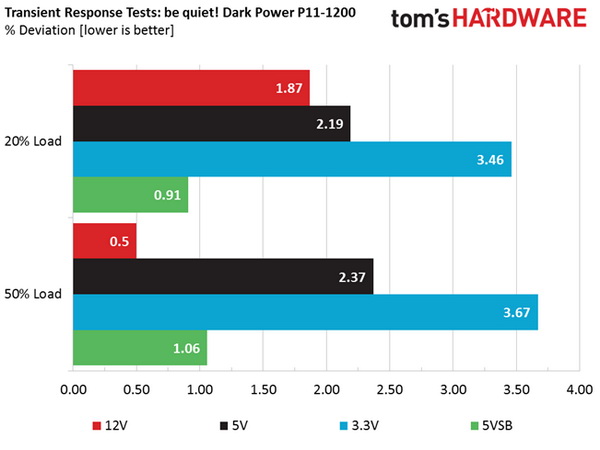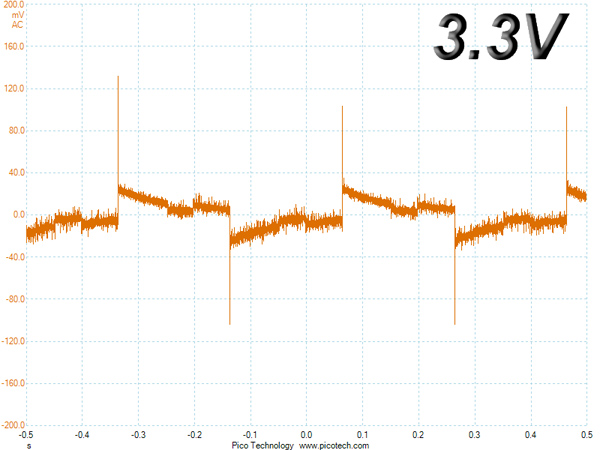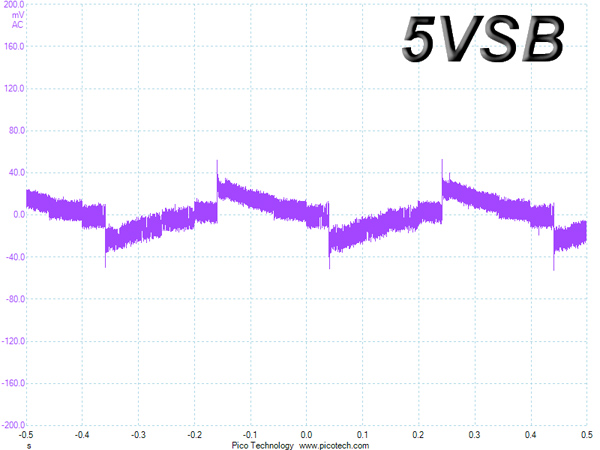Be Quiet! Dark Power Pro 11 1200W PSU Review
be quiet! says it's committed to building silent products, including the company's top PSU line, the Dark Power Pro 11. In this review, we will put the 1200 W Dark Power Pro 11 model to the test, which promises good performance and silent operation.
Why you can trust Tom's Hardware
Transient Response Tests
Advanced Transient Response Tests
For details on our transient response testing, please click here.
In these tests, we monitored the response of the PSU in two different scenarios: First, a transient load (10A at +12V, 5A at 5V, 5A at 3.3V and 0.5A at 5VSB) was applied to the PSU for 200ms while the PSU was working at 20 percent load. In the second scenario, the PSU was hit by the same transient load while operating at 50 percent load. In both tests, we used our oscilloscope to measure the voltage drops caused by the transient load. The voltages should have remained within the ATX specification's regulation limits.
These tests are crucial because they simulate the transient loads a PSU is likely to handle (such as booting a RAID array, an instant 100-percent load of CPU/GPUs, etc.). We call these tests "Advanced Transient Response Tests," and they are designed to be very tough to master, especially for a PSU with a capacity of less than 500W.
Advanced Transient Response at 20 Percent
| Voltage | Before | After | Change | Pass/Fail |
|---|---|---|---|---|
| 12V | 12.006V | 11.781V | 1.87% | Pass |
| 5V | 5.019V | 4.909V | 2.19% | Pass |
| 3.3V | 3.352V | 3.236V | 3.46% | Pass |
| 5VSB | 5.063V | 5.017V | 0.91% | Pass |
Advanced Transient Response at 50 Percent
| Voltage | Before | After | Change | Pass/Fail |
|---|---|---|---|---|
| 12V | 11.964V | 11.904V | 0.50% | Pass |
| 5V | 4.984V | 4.866V | 2.37% | Pass |
| 3.3V | 3.323V | 3.201V | 3.67% | Pass |
| 5VSB | 5.020V | 4.967V | 1.06% | Pass |





In the first test, the deviation on the +12V rail was high, most likely because of the PWM-mode operation of the primary switches. However, in the second test, the deviation on the same rail dropped significantly, at the levels that we expect to see from a PSU with such high capacity. Finally, on the 5V and 5VSB rails, performance during these tests was good overall, while at 3.3V, we would like to see close to 3 percent deviations.
Here are the oscilloscope screenshots we took during advanced transient-response testing:
Transient Response At 20 Percent Load




Transient Response At 50 Percent Load




Turn-On Transient Tests
In the next set of tests, we measured the response of the PSU in simpler transient-load scenarios, during the PSU's power-on phase.
For the first measurement, we turned off the PSU, dialed in the maximum current the 5VSB could output and then switched the PSU back on. In the second test, we dialed the maximum load the +12V could handle and started the PSU while it was in standby mode. In the last test, while the PSU was completely switched off (we cut off the power or switched off the PSU by flipping its on/off switch), we dialed the maximum load the +12V rail could handle before switching on the PSU from the loader and restoring the power. The ATX specification states that recorded spikes on any rails should not exceed 10 percent of their nominal values (+10 percent for 12V is 13.2V, and 5.5V for 5V).
Get Tom's Hardware's best news and in-depth reviews, straight to your inbox.



We noticed only two small spikes during the last two tests, which took place after the rails settled down. We remember seeing something similar in the past in Seasonic's high-end implementations. In this specific case, the spikes are way lower than the limits that the ATX spec sets, so they don't pose any threat to the components that the PSU will feed with power.
Current page: Transient Response Tests
Prev Page Cross-Load Tests And Infrared Images Next Page Ripple Measurements
Aris Mpitziopoulos is a contributing editor at Tom's Hardware, covering PSUs.
-
Blueberries -12V Rail is very cool. These are really well built PSUs. I'd rather have a SeaSonic SS-1200 at this price range. I was expecting a better transient response change on the 5V rail, oh well.Reply -
chalabam Interesting, but way too much focus on PSUs over the kW, when the system builder marathons had peak overclocked power at 750w (and mostly 500w) for years now.Reply
And those computers spend most of the time running at 50/100 w, where even this unit efficiency is poor.
Good review, anyway, but I think that Tomshardware should focus on units that readers are more probable to buy. That info is more useful. -
chalabam Reply16727117 said:-12V Rail is very cool. These are really well built PSUs. I'd rather have a SeaSonic SS-1200 at this price range. I was expecting a better transient response change on the 5V rail, oh well.
Why you need 1200 W? What are you running? -
Blueberries Reply16727128 said:16727117 said:-12V Rail is very cool. These are really well built PSUs. I'd rather have a SeaSonic SS-1200 at this price range. I was expecting a better transient response change on the 5V rail, oh well.
Why you need 1200 W? What are you running?
Just because it's rated for 1200W doesn't mean you're drawing 1200W from the wall. The PSU in the article is a 1200W PSU so it makes sense to compare the two.
16727124 said:Interesting, but way too much focus on PSUs over the kW, when the system builder marathons had peak overclocked power at 750w (and mostly 500w) for years now.
And those computers spend most of the time running at 50/100 w, where even this unit efficiency is poor.
Good review, anyway, but I think that Tomshardware should focus on units that readers are more probable to buy. That info is more useful.
Power supplies are more efficient and put off less heat when they're not near their maximum load. If your system draws 500W you don't want to use a 550W PSU, you would be straining the PSU. SLI/CrossFire builds with multiple graphic processors can achieve a power draw of over 750W on the PCI Express rails alone!
I don't have a use for 1200W, but that wouldn't stop me from paying extra for better components, efficiency, and reduced noise. -
Aris_Mp indeed a PSU's peak efficiency is with typical loads (40-50% of its max rated capacity). However you should also take into account how long your system operates at full load. For example if your system is mostly working at idle or at low utilization then you will probably have more gain with a lower capacity PSU rather than with a high capacity one. On the other hand at high loads the stronger PSU will be closer to its sweet spot, having higher efficiency.Reply -
Blueberries Replyindeed a PSU's peak efficiency is with typical loads (40-50% of its max rated capacity). However you should also take into account how long your system operates at full load. For example if your system is mostly working at idle or at low utilization then you will probably have more gain with a lower capacity PSU rather than with a high capacity one. On the other hand at high loads the stronger PSU will be closer to its sweet spot, having higher efficiency.
It is absolutely true that power supplies are usually at their best efficiency around 50% of their maximum load, but that doesn't necessarily mean a smaller PSU is better. An AX1500 can peak at ~94% 12V efficiency, which is really good, but even at 300W it's still producing 91% efficiency, and over 90% at 150W. -
Blueberries Reply16732572 said:The AX1500i is a very special case :)
Be that as it may it's important to look at all of the factors. Amperage, Ripple, Efficiency, Hold-up, etc. Most important of all of course is build integrity and architecture. The best PSUs do have high loads, because well, they can handle it. They'll also last longer at any load.
An average load for an i7 user with a single high-powered video card is ~350W (gaming), a 980ti under maximum stress can be a 300-350W draw alone, bringing that up to a potential ~550W. In this scenario an RM750X is gold rated and will perform better than a Supernova P2 650W which is platinum rated. Both are extraordinary power supplies and I'd use either one. My point is, maximum load shouldn't matter. If a power supply meets more than your demands consider that a good thing. Most people aren't going to buy these PSUs unless they have a use for them because there's other options available.
The Dark Power Pro 11 in this article retains >90% efficiency from 200W-800W, which is a wide range, and your system load would want to fall between that range to be in the "sweet spot." A smaller PSU has a much smaller "sweet spot," but it could prove to be better. -
mctylr Replyindeed a PSU's peak efficiency is with typical loads (40-50% of its max rated capacity). However you should also take into account how long your system operates at full load.
It is absolutely true that power supplies are usually at their best efficiency around 50% of their maximum load, but that doesn't necessarily mean a smaller PSU is better.
All switching power supplies decrease their efficiencies as their load decreases, typically starting at or near 50% load and often rapidly decreasing efficiencies as their load falls below 20%.
For desktop systems, unless you run a distributed computation project in the background, 80-95% of the time the system is powered on, the system is idle or near-idle. In my limited testing a desktop system likely draws 50-100W at idle, so with a 1000W power supply it's operating at 5-10% load, and thus at its worst efficiencies.
With Haswell and newer consumer Intel's CPUs maxing out at 145W (I believe) at stock frequencies, and most video cards needing under 200-250 W maximum (980Ti 250W), a system with a single GPU rarely needs more then 600W.
Specifying the PS for 50% load (for maximum efficiency) to match the maximum load the system is actually capable of drawing is a poor efficiency trade-off, as the system will spend the majority of time time at under 20% utilization, at its worst efficiency, that the few percentage points of increased efficiency (at 50% load versus moderately higher loads) will result in a net lost.
Edited: Clarify first paragraph -
Blueberries Reply16734708 said:indeed a PSU's peak efficiency is with typical loads (40-50% of its max rated capacity). However you should also take into account how long your system operates at full load.
It is absolutely true that power supplies are usually at their best efficiency around 50% of their maximum load, but that doesn't necessarily mean a smaller PSU is better.
All switching power supplies decrease their efficiencies as their load decreases, typically starting at or near 50% load and often rapidly decreasing efficiencies as their load falls below 20%.
For desktop systems, unless you run a distributed computation project in the background, 80-95% of the time the system is powered on, the system is idle or near-idle. In my limited testing a desktop system likely draws 50-100W at idle, so with a 1000W power supply it's operating at 5-10% load, and thus at its worst efficiencies.
With Haswell and newer consumer Intel's CPUs maxing out at 145W (I believe) at stock frequencies, and most video cards needing under 200-250 W maximum (980Ti 250W), a system with a single GPU rarely needs more then 600W.
Specifying the PS for 50% load (for maximum efficiency) to match the maximum load the system is actually capable of drawing is a poor efficiency trade-off, as the system will spend the majority of time time at under 20% utilization, at its worst efficiency, that the few percentage points of increased efficiency (at 50% load versus moderately higher loads) will result in a net lost.
Edited: Clarify first paragraph
Yes but titanium efficiency PSUs retain 90% efficiency at a 10% load and platinum achieve at least 90% efficiency at 20% load. See: https://en.wikipedia.org/wiki/80_Plus
If the components are good they'll be able to handle a large load. There's no such thing as a good PSU that can't handle a large load. Most platinum PSUs can handle well over what they're rated for.